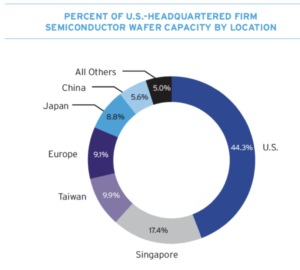Calls Grow Louder for US Chip Revival

Source: NIST
Technology industry lobbyists are capitalizing on the growing Washington consensus for a next-generation industrial policy that funds basic research in foundational silicon technology as a way to compete with China in strategic markets like AI, 5G and quantum computing.
Separate reports released this week make the case for expanding government incentives for reviving domestic chip manufacturing while reconstituting global supply chains to re-shore key capabilities like chip assembly, testing and packaging.
“The increasing expense, complexity and scale required to innovate and manufacture semiconductors means that no single nation or enterprise can go it alone,” concludes a report released this week by the Information Technology & Innovation Foundation.
“In the face of challenges from China, allied cooperation in semiconductors is critical,” added Stephen Ezell, ITIF’s vice president for global innovation policy and author of the report.
U.S. chip makers account for an estimated 48 percent of global chip sales, and remain leaders in areas like chip design and IC manufacturing gear. Those design and process capabilities have been walled off from Chinese companies like Huawei Technologies through a series a stringent U.S. export controls.
Still, the pandemic has exposed supply chain vulnerabilities that have prompted industry groups to lobby for incentives to re-shore chip making. Bipartisan legislation currently working its way through the congressional appropriations process largely responds to this advocacy.
Along with countering Beijing’s aggressive campaign to forge and indigenous chip industry, industry groups are advocating for greater incentives to restart the domestic chip manufacturing sector that would underpin AI, quantum computing and HPC technologies.
“With a reduced, shrinking manufacturing footprint, the U.S semi- conductor industry would be challenged to stay at the forefront of further advances in manufacturing-processing technology, architectures, and materials critical for developing the next generations of semiconductors that will make artificial intelligence or quantum computing possible,” the Semiconductor Industry Association (SIA) argued in a separate study released this week.
SIA counts 70 commercial chip fabs currently operating in the U.S. Those facilities account for an estimated 44.3 percent of domestic wafer capacity, much of it classified as “front-end” chip manufacturing. Still, U.S.-based fabs account for only 12 percent of global chip output, down from 37 percent in 1990.
The industry group argues in its report that “robust federal incentives” would seed as many as 19 “major” semiconductor manufacturing facilities in the U.S. That would require U.S. manufacturing grants and tax breaks totaling as much as $50 billion, SIA asserted.
“The U.S. leads in advanced chip research, design, and manufacturing will have a big leg up in the global race to deploy new game-changing technologies, such as 5G, artificial intelligence and quantum computing,” said SIA President John Neuffer.
The growing chorus of calls for economic incentives to revive U.S. chip manufacturing stems from Beijing’s massive investment in a “Made in China” initiative designed in part to reduce its chip imports. The tipping point in the re-shoring debate arrived with the pandemic, which exposed vulnerable technology supply chains.
Still, industry groups note the key issue is the declining U.S. share of global chip manufacturing rather than the relatively small percentage of U.S. chips made in China. “The reality is China accounts for less than 2 percent of all U.S.-owned and operated fabs around the world, and a mere 5.6 percent of total global U.S. semiconductor industry front-end capacity,” SIA noted in a July blog post.
ITIF, meanwhile, advocates a collaborative approach among western countries. “Like-minded nations should come together to open trade and fair economic competition and collaborate in ways that collectively empower the competitiveness of their respective semiconductor industries,” Ezell said.
According to budget estimates, proposed legislation aimed at reviving U.S. chip making would provide $3 billion in grants for U.S. fab construction and modernization and $914 million for semiconductor research.
Related
George Leopold has written about science and technology for more than 30 years, focusing on electronics and aerospace technology. He previously served as executive editor of Electronic Engineering Times. Leopold is the author of "Calculated Risk: The Supersonic Life and Times of Gus Grissom" (Purdue University Press, 2016).











